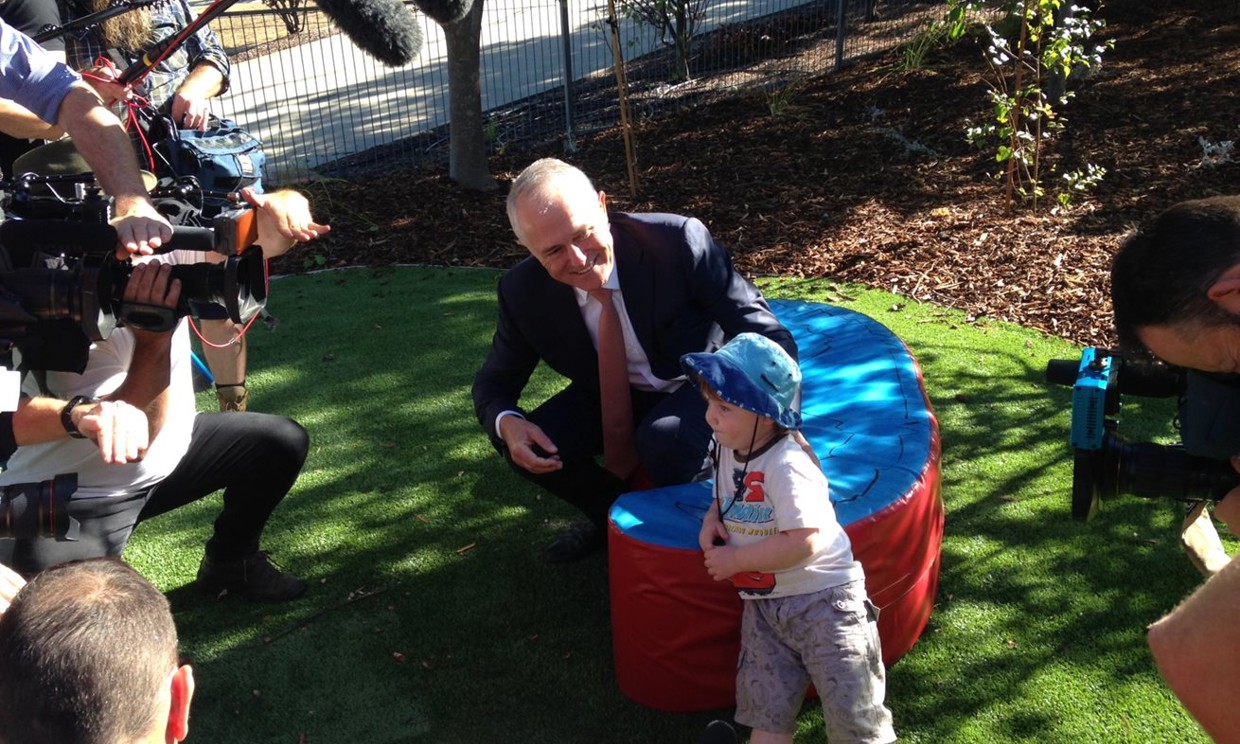Prime Minister Malcolm Turnbull and Education Minister Simon Birmingham visited Goodstart Early Learning Isaacs in Canberra today (February 13), with child care reforms firmly on the agenda.
While children played in the background, Goodstart Early Learning CEO Julia Davison told Mr Turnbull and Mr Birmingham proposed child care reforms would give parents more options about working more days.
She said more than 120,000 families will hit the $7500 Child Care Rebate cap this year, with many reducing their work hours as a result.
“The current rebate only supports three days of child care over a year at average fees, and even fewer days for families paying above average fees,” Ms Davison said.
“Under the Government’s proposed child care reforms, the cap will be removed for the vast majority of Australian families.”
Mr Turnbull said under his reforms, those families who worked the most hours would get the most hours of care, and that the largest amount of the subsidy would go to families on the lowest incomes.
The cap will be removed for 85 per cent of families earning less than $185,000 and increased to $10,000 for families on higher incomes.
“Families said that the cap on child care assistance acts as a huge impediment for parents wanting to work more than three days a week as the economics of working simply doesn’t stack up,” Ms Davison said.
Mr Birmingham thanked Ms Davision for hosting the meeting, saying Goodstart Early Learning provided outstanding early education and care to thousands of Australian children every day.
A Goodstart Early Learning survey found that more than half of the respondents ran out of rebate last year, highlighting a growing child care affordability issue for families as child care reforms are due to be debated in Parliament.
The Child Care Rebate cap has been frozen at $7,500, 2008 levels, under successive governments, failing to take into account rising costs of living and stagnant wages over the same period.
More than 120,000 families or around one in six families in long day care centres will exceed the cap this year.
Ms Davison said that in 2008, the $7500 cap covered 50 weeks of child care for a family using a typical service full time. By 2016, that has fallen to around 30 weeks of child care.
“That means that families face a doubling of their out of pocket costs for many more weeks of the year, putting serious strain on the family budget,” she said.
“While most families reported that they cut back their discretionary spending, others reported more difficult financial issues including struggling to pay their mortgage, education costs and household bills. Others reported that they had been forced to stop savings for a home or delayed having another child.
“For a family earning $150,000 with a child in a typical child care centre five days a week, removal of the cap will reduce their out of pocket expenses by around $5000 a year, or $97 a week.
“That will have a big impact on families’ decisions about work. Modelling by PWC of the impact of child care reforms found that around half of the increase in workforce participation is from parents working extra days.
“PWC found that child care reform will pay for itself with the increase in workforce participation providing a $3 billion boost to the economy and increase taxes paid to the Government by $1 billion within three years.
“Investing in child care will be good for families and good for the Australian economy,” Ms Davison said.
Australia has the 29th lowest rate of maternal employment of 41 OECD countries, and the lowest rate of full time employment (after Turkey). While more than 55 per cent of mothers in Canada, France and Denmark work full time, just 26 per cent of Australian mothers work full time.
About the survey
Conducted over a four week period in October 2016 the survey* found of the 2353 parents with children in early learning care found many were struggling with the gap.
Key findings:
- 83% of the 2,353 parents who responded were from working couples.
- 68% of them had one child in early learning and a further 29% had two.
- Most children attend child care for five days (29%) or three days (29%) a further 20% attend for four.
- 54% of respondents hit the cap in 2015-16 – with almost half running out of rebate by the end of April.
- Hitting the cap in March for a family with two children in care five days a week paying the Australian average daily cost of child care ($90 per day) means finding $14,400 for the quarter
- 64% of those families who hit the cap were forced to reduce their discretionary spending, cutting back on family outings, meals and entertainment.
- If the cap were removed 55% of respondents said they would consider more work or study.
The survey asked supporters of the Smart Start campaign www.thesmartstart.com.au , supported by Goodstart Early Learning, to answer a series of questions about the number of children they had in care, how many days they spent there, their family circumstances, if and when they hit the Federal Government’s rebate cap. Total responses: 2426 of whom 2353 had children in formal childcare. State figures – Qld – 689, Vic – 576, NSW – 532, WA – 213, SA – 128, Tas – 8 and NT – 5. No postcode supplied by 275 respondents.


